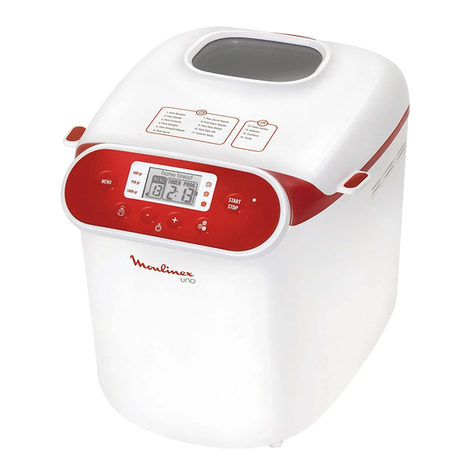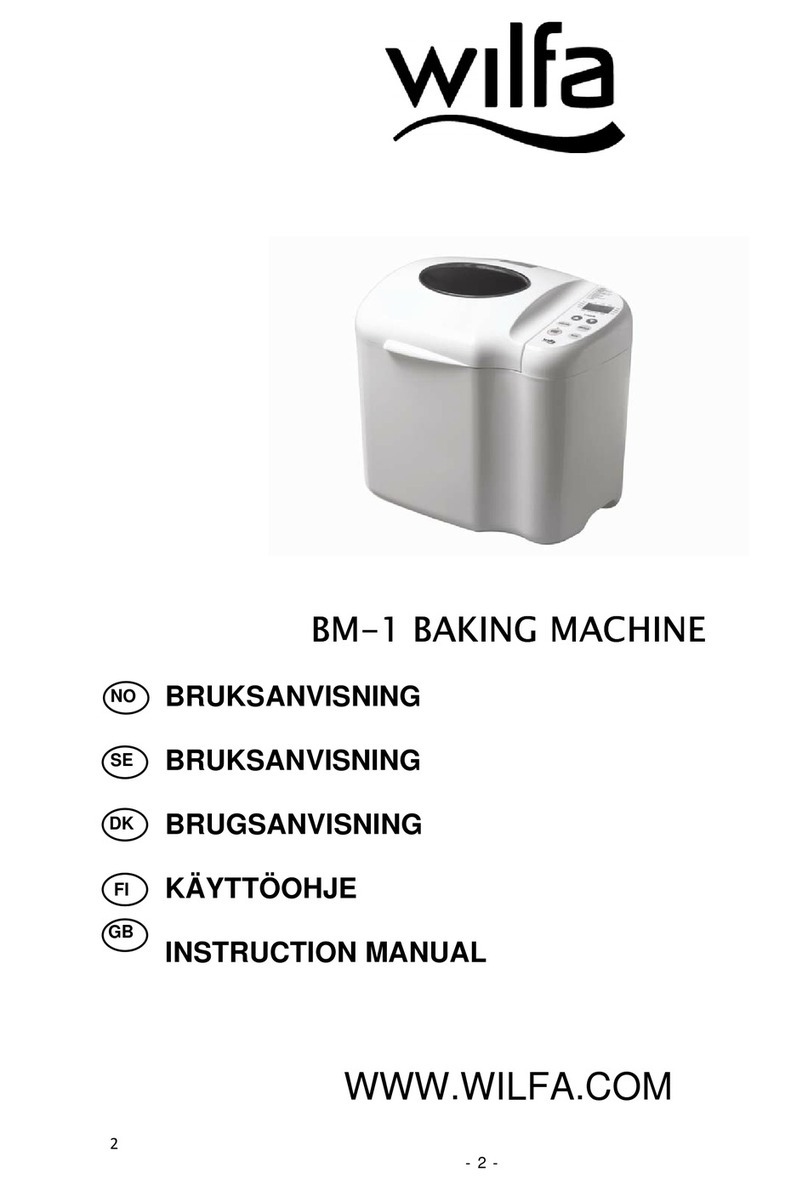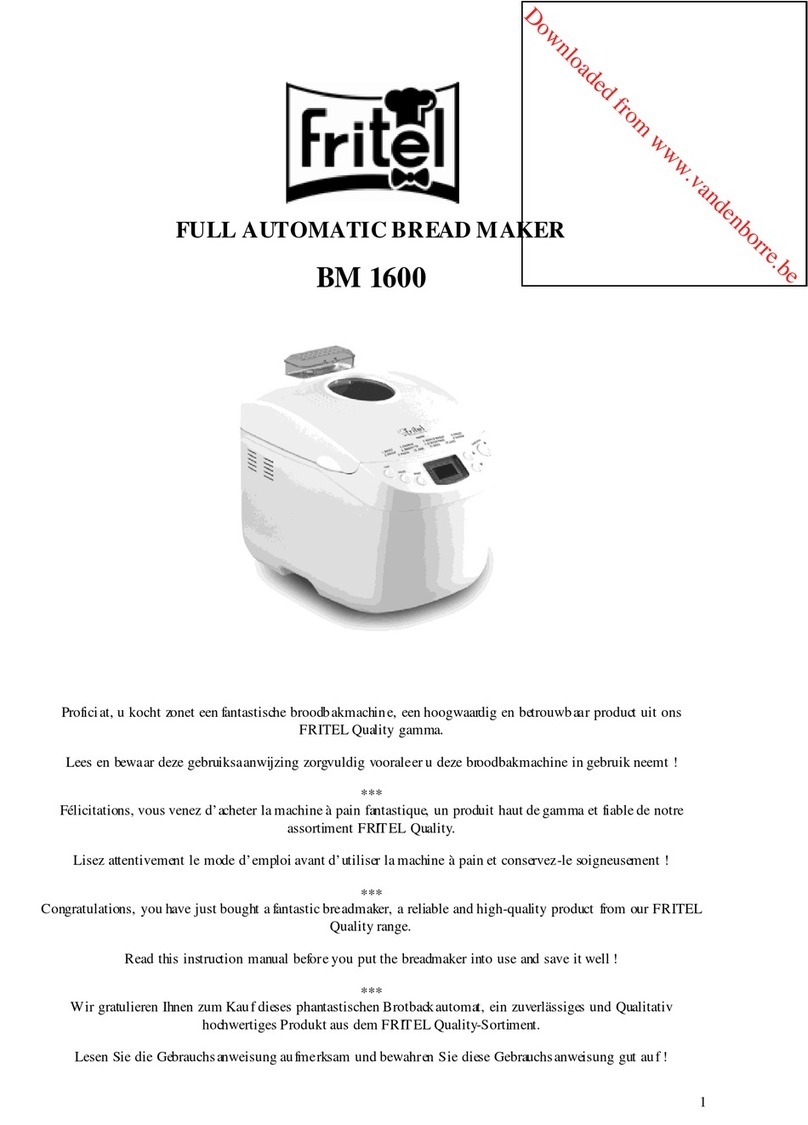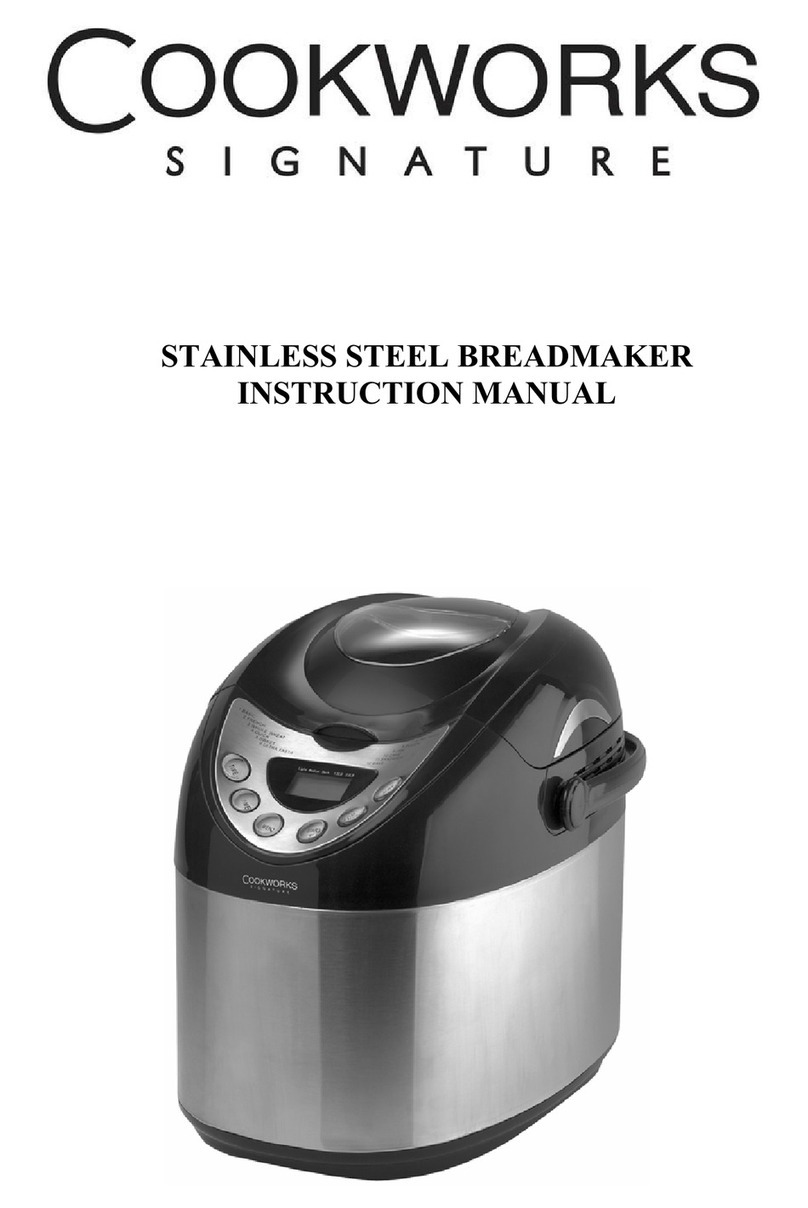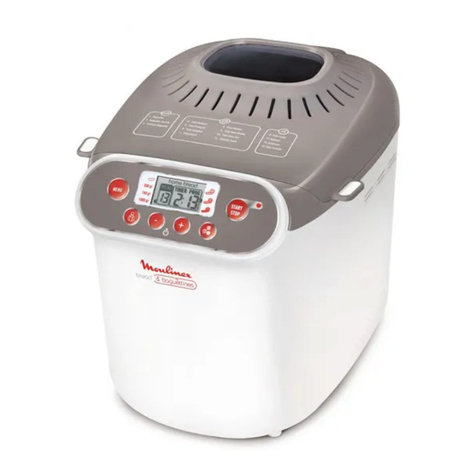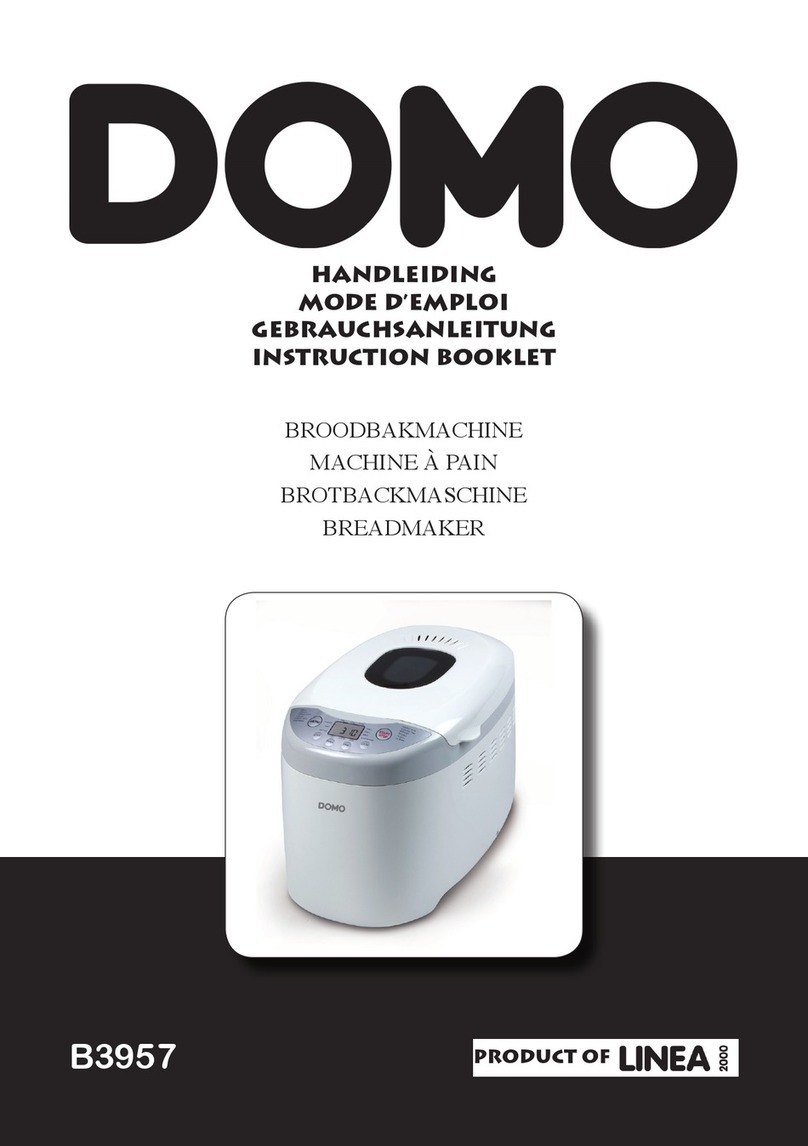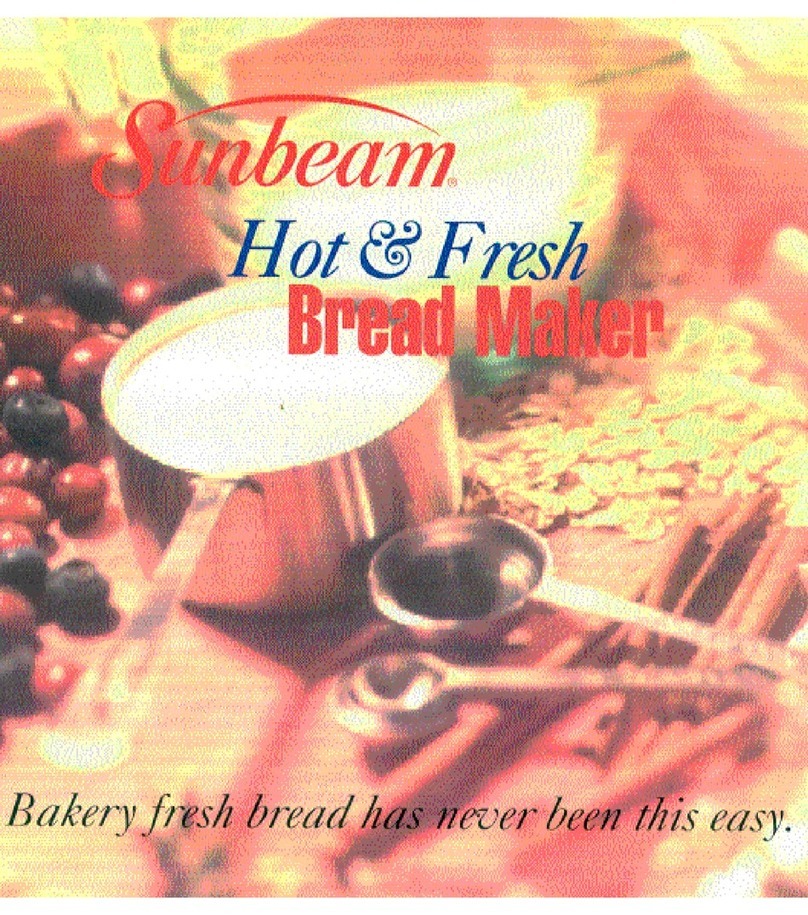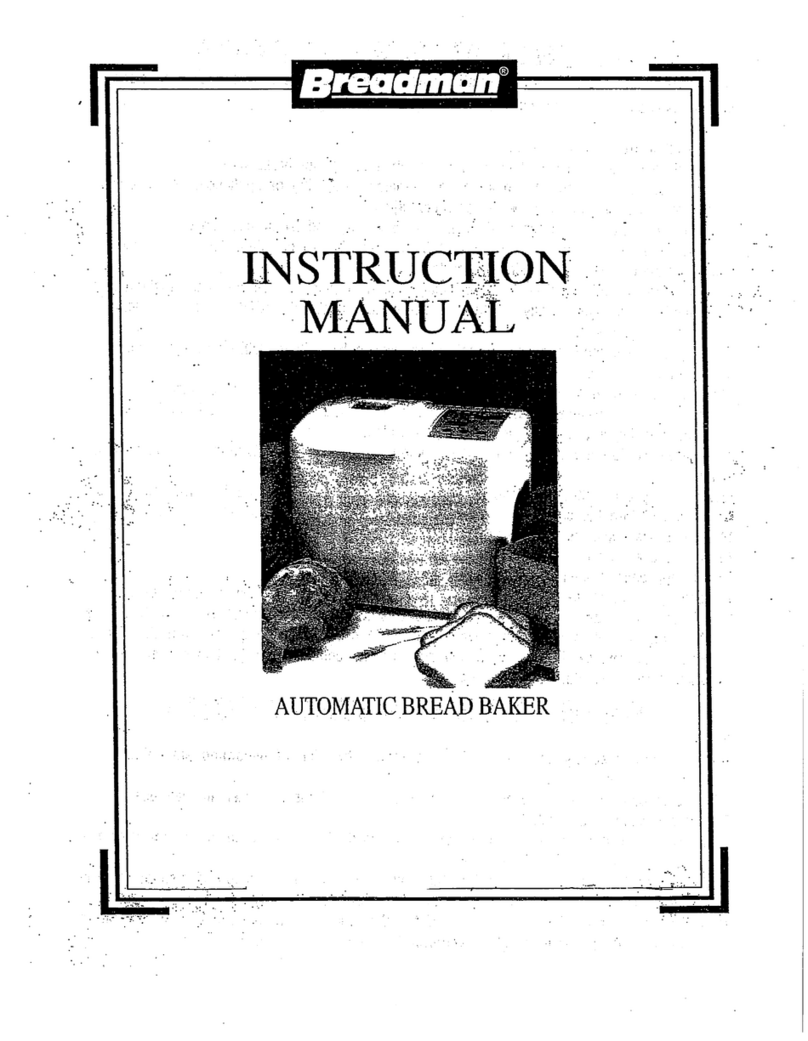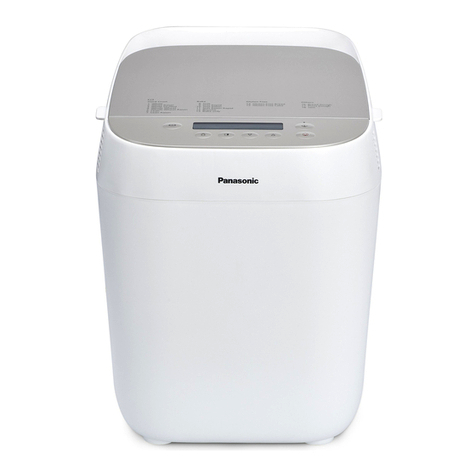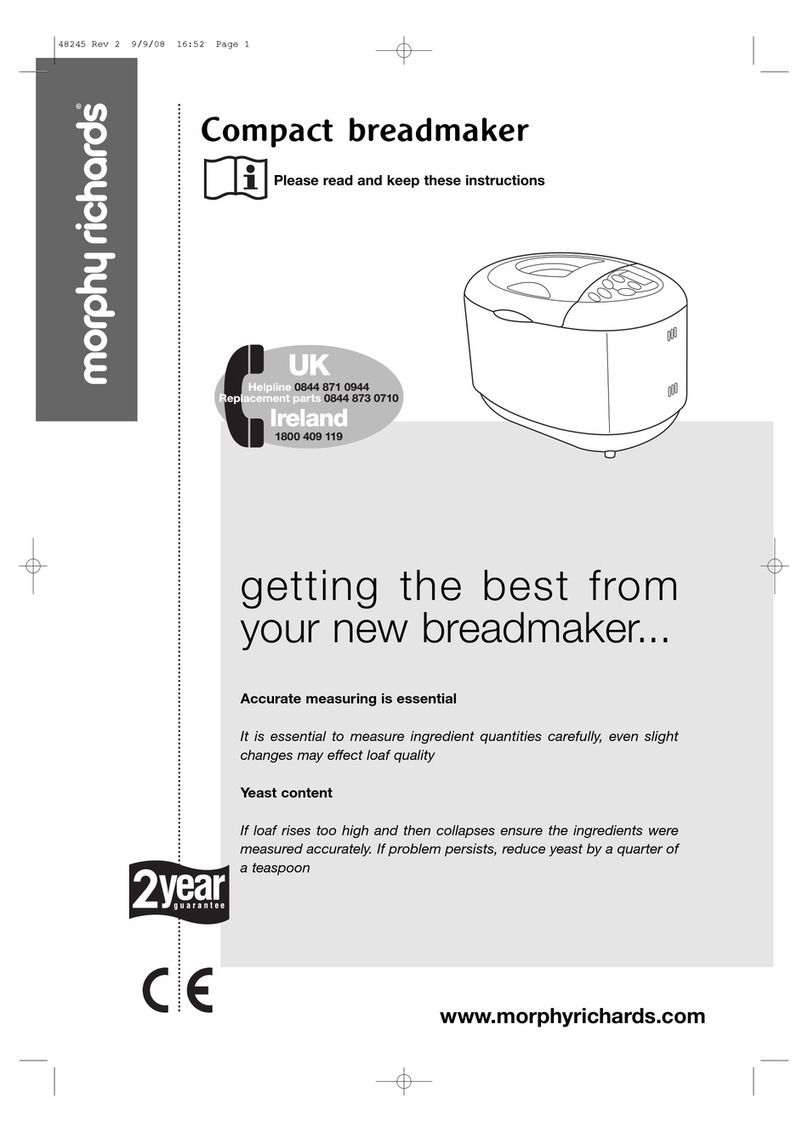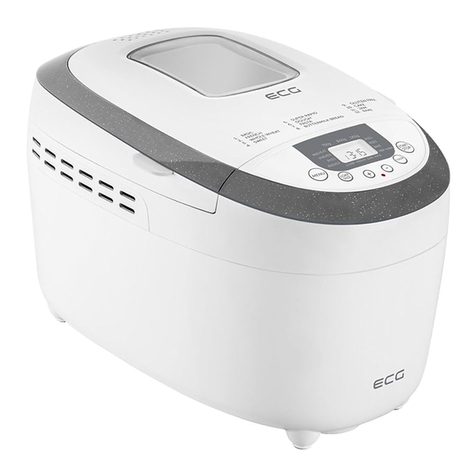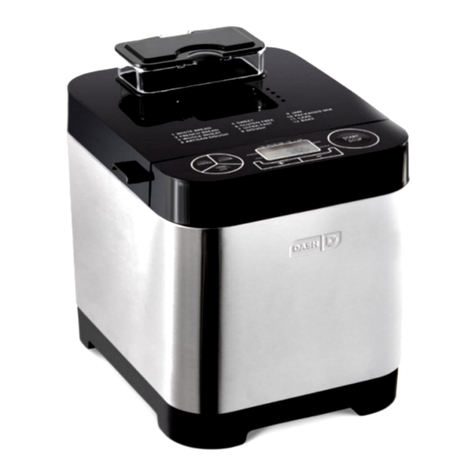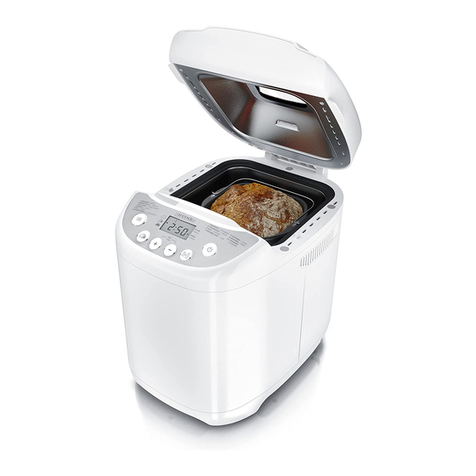RONDELL RDE-1640 User manual

RDE-1640

РАЗМО-
РОЗКА
ЖАРЕ-
НЫЕ
ОРЕШКИ
1
12
29
21
25
20
19
22
28
15
10911
3
16
13
17
18
6
8
7
4
2
27
24
26
14
23
5

4GB MANUAL INSTRUCTION
12DE DIE BETRIEBSANWEISUNG
21RUS ИНСТРУКЦИЯ ПО ЭКСПЛУАТАЦИИ
www.rondell.ru
ХЛЕБОПЕЧКА
BREAD MAKER
RDE-1640

4
ENGLISH
BREAD MAKER RDE-1640
The home bread maker is intended for baking bread, cakes,
making jam and yogurt.
DESCRIPTION
1. Body
2. Control panel
3. Cover
4. Viewing window
5. Automatic ingredient adding container
6. Handle
7. Baking form
8. Kneading paddle
9. Beaker
10. Measuring spoon
11. Hook for removing the paddle
Control panel
12. Navigation buttons p q t u
13. Quick baking start button “BAKING”
14. Display
15. ON/OFF button «START/STOP»
16. «FERMENT» button for fermenting mode
17. «MULTIBAKER» mode button
18. «OK» button for operation start
Display (14)
19. Dough proofing (rising) symbol
20. Dough kneading symbol
21. Crust color selection symbol
22. Loaf weight selection symbol
23. Baking symbol
24. Keep warm mode symbol
25. Remaining/delay time digital indications
26. Operation program indication
27. «MULTIBAKER» mode symbol
28. Remaining/delay time symbols
29. Ingredient adding indication
ATTENTION!
For additional protection it is reasonable to install a resid-
ual current device (RCD) with nominal operation current not
exceeding 30 mA. To install the RCD contact a specialist.
SAFETY MEASURES
Read this instruction manual carefully before using bread
maker and keep it for the whole operation period. Use
the unit for intended purposes only, as specified in this
manual. Mishandling of bread maker can lead to its
breakage and cause harm to the user or damage to his/
her property.
•
Before plugging the unit in make sure that the operating
voltage of the unit corresponds to the voltage of your mains.
•
The power cord is equipped with a “euro plug”; plug it into
the socket with reliable grounding contact.
•
To avoid fire or electric shock do not use adapters for plug-
ging bread maker in.
•
Place the unit on a flat, stable heat-resistant surface with
free access to the mains socket. The distance to the near-
est objects should be at least 20 cm.
•
Never cover bread maker during operation to avoid fire
outbreak.
•
Do not place the unit on other household equipment or
table cloths.
•
Do not place the unit near open flame sources, highly
inflammable substances or in direct sunlight.
•
Do not let the power cord hang from the table or come
into contact with hot surfaces or sharp edges of kitchen
furniture.
•
Do not use the unit outdoors.
•
Always switch bread maker off before assembling, disas-
sembling or cleaning.
•
Never use the bread maker without automatic ingredient
adding container installed. Handle the container carefully
to avoid damaging it.
•
Never leave the operating bread maker unattended.
•
In case of improper use of the unit (for example, non-com-
pliance to the recommendations), bread burning and
smoke appearance is possible. In this case switch the unit
off and unplug it. Before cleaning remove the baking form
and let the unit cool down completely.
•
Placing foreign objects in the process chamber is forbidden.
•
Do not open the bread maker lid or leave it open during the
unit operation.
•
During the operation do not touch hot surfaces of the
bread maker.
•
Do not block ventilation openings in the bread maker lid.
•
Do not put your hands into the process chamber of the
bread maker during the automatic program operation.
•
When taking baked bread out hold the handle of the baking
form after putting on thermal protective potholders.
•
In order not to damage the baking form non-stick coat-
ing do not tap on the form bottom or edges and do not
use metal objects when taking bread out but turn the form
upside down and shake the ready bread out of it.
•
Always unplug the unit before cleaning or when you are
not using it.
•
When unplugging the unit, do not pull the power cord, hold
the plug.
•
Do not touch the power plug with wet hands.
•
Do not use the unit near the kitchen sink, do not expose it
to moisture.

5
ENGLISH
•
To avoid electric shock do not immerse the power cord,
the power plug or the bread maker body into water or any
other liquids. If the unit is dropped into water: - do not
touch the unit, unplug it immediately and only then take
the unit out of the water. For testing or repairing the unit
apply to the nearest authorized service center at the con-
tact addresses given in the warranty certificate and on the
website www.rondell.ru.
•
For children safety reasons do not leave polyethylene bags
used as packaging unattended.
Attention! Do not allow children to play with polyethylene bags
or packaging film. Danger of suffocation!
•
This unit is not intended for usage by children.
•
Place the unit out of reach of children during the operation
and cooling down.
•
Do not allow children to touch the unit and the power cord
during the unit operation.
•
The unit is not intended to be used by persons (including
children) with any physical, sensory or mental disabilities
or by persons lacking life experience or knowledge if they
are not under supervision of a person responsible for their
safety or if they are not instructed by this person on the
usage of the unit.
•
Do not leave children unattended to avoid them using the
unit as a toy.
•
Periodically check the power cord and power plug integrity.
•
Do not use the bread maker if the power cord or the power
plug are damaged, if the unit works improperly, after it was
dropped or was damaged in some other way.
•
If the power cord is damaged, it should be replaced by the
manufacturer, a maintenance service or similar qualified
personnel to avoid danger.
•
Do not repair the unit by yourself. Do not disassemble the
unit by yourself, if any malfunction is detected or after it was
dropped, unplug the unit and apply to any authorized ser-
vice center at the contact address list, given in the warranty
certificate and on the website www.rondell.ru.
•
Transport the unit in the original package.
•
Keep the unit in a dry cool place out of reach of children and
people with disabilities.
THIS UNIT IS INTENDED FOR HOUSEHOLD USE ONLY. ITS
COMMERCIAL USAGE AND USAGE IN PRODUCTION AREAS
AND WORK SPACES IS PROHIBITED.
BEFORE THE FIRST USE
After unit transportation or storage at low temperature
keep it for at least three hours at room temperature
before switching on.
•
Unpack the unit and remove any stickers that can prevent
its operation.
•
Check the unit for damages, do not use it in case of dam-
ages.
•
Take the automatic ingredient adding container (5) and
remove it from the lid (3).
•
Open the lid (3) taking it by the handle (6).
•
Take the handle of the baking form (7) and lift it, turn the
handle counterclockwise and remove the baking form (7).
•
Wash the container (5), the baking form (7), the paddle (8),
the beaker (9), the spoon (10) and the hook (11) in warm
water with a neutral detergent and then dry them thoroughly.
•
Clean the bread maker body (1) and the lid (3) with a soft,
slightly damp cloth, and then wipe them dry.
•
Install the baking form (7) back to its place and turn it clock-
wise until bumping, install the kneading paddle (8) on the
axle in the baking form (7).
•
Close the lid (3) and install the container (5) into it.
•
Place the unit on a flat, dry, heat-resistant and stable surface.
Distance to the nearest surfaces should be at least 20 cm.
•
The bread maker is ready for operation.
Notes:
–
The bread maker is intended for operation within a wide
range of temperatures, but excessively high or low tem-
perature in the room affects dough rising process and con-
sequently the size and density of bread. The most optimal
room temperature is from +15 to 34°С.
CONTROL PANEL (2)
You can use the control panel (2) buttons to select the neces-
sary automatic program and set the delay time and the display
(14) to control the whole baking process.
Every pressing of the control panel buttons is accompanied
by a sound signal.
Operation modes
Press the buttons (12) to select an automatic program, the
program names will be shown on the display (14) with the sym-
bols (26). There are 25 automatic programs total:
1. «BASIC MODE». It includes all stages of bread making:
dough kneading, proofing (rising) and baking. You can also
add necessary ingredients to improve the taste of the ready
pastry by putting them into the container (5).
2. «RUSTIC BREAD». Bread making takes more time, the
bread has large porous crumb and crispy crust.
3. «WHOLE-WHEAT BREAD». Bake healthy bread of fine
or crude flour. It is not recommended to use the delay func-
tion when making this bread as that may cause undesirable
effects.
4. «FANCY BREAD». Add leaven or soda to sweet dough
and make savory pastry.
5. «DIET BREAD». Low sugar bread baking mode.
6. «RICE BREAD». Rice flour bread baking mode.

6
ENGLISH
7. «RYE BREAD». Rye flour bread baking mode.
8. «FAST BAKING». Bread making takes less time than in the
«BASIC MODE», but the bread is usually smaller in size and has
denser crumb.
9. «ITALIAN BREAD». Bake bread with softer and denser
crumb.
10. «GLUTEN FREE». Gluten free bread baking mode.
11. «PIZZA DOUGH». Pizza dough cooking mode: knead-
ing and rising of the pizza dough. Use the prepared dough to
make pizza.
12. «YEASTED DOUGH». Yeasted dough cooking mode.
12. «DOUGH RISE». The bread maker kneads dough and
lets it rise. Use this dough to make home-baked pastry
(pies etc.).
14. «FERMENTING». Heating mode with low temperature,
you can set the desired time within the specified range.
15. «YOGURT». Low heating only. You can set the yogurt mak-
ing time.
16. «DEFROSTING». Vegetables defrosting mode.
17. «DOUGH KNEADING». Dough making mode: kneading
and rising of the dough without further cooking. Use the pre-
pared dough for making bread.
18. «JAM». Make savory homemade jam, marmalade or
confiture. Cut the fruit before making jam, marmalade or con-
fiture.
19. «BAKING». Bread maker works as an ordinary electric
oven. The program does not include dough kneading and ris-
ing modes. The program is used for baking from ready-made
dough or for baked bread additional browning.
20. «ROASTED NUTS». Operating mode for roasting nuts.
The program switches the heating on without stirring.
21. «MEAT FLOSS». Cooking mode for making meat floss.
22. «RICE VINEGAR». Rice vinegar cooking mode.
23. «BISCUIT». Cooking program for making sweet pastry.
You can add ingredients to improve the taste of pastry.
24. «ITALIAN CAKE». Cooking program for making biscuits of
your choice.
25. «MULTIBAKER». Baking mode with manual setting of
temperature and time.
Operation time of automatic programs is shown directly on the
display with digital indications (25).
Crust color selection
You can select one of three ready bread crust colors :
light, medium, dark.
–
Select the required crust color with the navigation buttons
(12) t u , the selected color will be shown on the display
(14) with the symbol (21).
Notes: This function is not available for the programs: «FAST
BAKING», «PIZZA DOUGH», «YEASTED DOUGH», «DOUGH
RISING», «FERMENT», «YOGURT», «DEFROSTING», «DOUGH
KNEADING», «JAM», «ITALIAN CAKE», «BISCUIT», «RICE VIN-
EGAR», «ROASTED NUTS», «MULTIBAKER».
Start/stop
–
Select the necessary operating program (26) with the navi-
gation buttons (12) t u . The selected program (26) will be
flashing on the display (14). Press the «OK» button (18) to
confirm the selected program.
–
Select the desired crust color with the naviga-
tion buttons (12) t u . One of the three symbols (21) will be
flashing on the display (14). Press the «OK» button (18) to
confirm the color.
–
Select the required weight of the loaf (22) of three
options with the navigation buttons (12) t u : 500 g, 700 g
and 900 g. Press the «OK» button (18) to confirm the
selected weight. One of the three symbols (22) will be flash-
ing on the display (14).
–
You can also use the navigation buttons (12) t u to add the
required amount of raisin to the dough (29) and to set the
delayed start time (28). Confirm the selected settings with
the «OK» button (18).
–
Press the button (15) once more to resume operation.
–
Cancelling the automatic program. To cancel the auto-
matic program press and hold down the button (15) for
3 seconds, you will hear a sound signal and the program
will be cancelled.
–
During the automatic program operation other control panel
(2) buttons are locked.
Setting the delay time
You can pre-set the time when the automatic program is to
be finished.
–
Use the navigation buttons (12) t u to select the required
automatic program (26), the crust color (21), the weight
(22) and the delayed start time symbol (28) .
–
After that, set the delay time by pressing the buttons (12)
t u again (please, note, that you should take into account
the running time of the automatic program while setting the
delay time). The delay time will be shown on the display (14)
with digital indications (25).
Notes: the maximal time of delay is 13 hours, setting step is
10 minutes.
Example:
If it is 20:00 now, you have set the «BASIC MODE» automatic
program «1» and you want fresh bread to be ready by 7 o’clock
next morning, set the delay time of 8 hours with the buttons (12)
(the «BASIC MODE» program «1» operation time is 3 hours).
–
After the delay time has been set press the «OK» «START/
STOP» button (18), the digital symbols in the remaining
time indications (25) will be flashing on the display (2) and
the countdown to the automatic program launch will start.

7
ENGLISH
–
To cancel the delay press and hold down the «START/
STOP» button (15) for 3 seconds, you will hear a sound
signal.
Notes:
–
The delayed start function is not available for the fol-
lowing programs: «PIZZA DOUGH», «YEASTED DOUGH»,
«DOUGH RISING», «FERMENT», «YOGURT», «DEFROST-
ING», «DOUGH KNEADING», «JAM», «ITALIAN CAKE»,
«BISCUIT», «RICE VINEGAR», «ROASTED NUTS».
–
Do not use the delay function when using perishable foods
such as milk, eggs, fruit, etc.
Loaf weight selection
You can select the loaf weight with the navigation buttons (12)
t u - 500 g, 750 g or 900 g. The selected weight is indicated
with the symbol (22) on the display (14). Confirm the selected
weight with the «OK» button (18).
Bread maker operations
The bread maker performs the following actions:
1. Kneading the dough to reach a homogeneous mass. The
kneading process is indicated with the symbol (20) on
the display (14).
2. Dough proofing (rise) - the process is indicated with the
symbol (19) on the display (14).
3. Baking - the process is indicated with the symbol (23)
on the display (14).
4. Keep warm - the symbol (24) is shown on the display
(14). The ready bread shall be kept warm for 60 minutes
after the automatic baking program is over. If you need to
remove the bread, switch the keep warm function off by
pressing and holding the «START/STOP» button (15).
Notes:
–
Never open the lid (3) during bread making, at sudden change
of temperature the dough can collapse and it will not rise.
–
You can control the bread making process through the
viewing window (4) in the lid (3).
ADDITIONAL FUNCTIONS
Ingredients adding
–
The unit is equipped with the container (5) for automatic
ingredient adding (fruit pieces, nuts etc.) during the dough
kneading.
–
Load the ingredients in the container (5) before the auto-
matic program start.
–
During the automatic program operation the lower lid of the
container (5) will open and the ingredients will be added
to the dough.
Notes: the ingredients adding function is not available for the
following programs: «PIZZA DOUGH», «YEASTED DOUGH»,
«DOUGH RISING», «FERMENT», «YOGURT», «DEFROSTING»,
«DOUGH KNEADING», «JAM», «ITALIAN CAKE», «BISCUIT»,
«RICE VINEGAR», «ROASTED NUTS», «BAKING».
Memory
–
In case of emergency power cutoff during the bread maker
operation, the memory function with the duration of up to
10 minutes is activated.
–
If the power supply is restored within 10 minutes, the bread
maker will continue to perform the pre-set program from
the moment the program operation has been stopped at.
–
If there is no power for more than 10 minutes it is neces-
sary to load the ingredients, set and switch the automatic
program on again.
USING THE BREAD MAKER
Before plugging the bread maker in make sure that the oper-
ating voltage of the unit corresponds to the voltage of your
mains.
Notes: During the first operation some smell from the heating
element is possible, this is normal.
–
Open the lid (3) and make sure that the baking form (7) and
the paddle (8) are installed to their places.
Notes: before installing the paddle (8) grease it with some mar-
garine or vegetable oil for easy removal from the fresh bread.
–
Put the ingredients into the form (7) in the sequence
described in the recipe. Usually the ingredients are added
in the following order:
1. liquids;
2. dry ingredients (sugar, salt, flour);
3. yeast and leaven.
Notes: Yeast should not come in contact with the liquids or
salt before the dough kneading. Make a small cavity in the flour
and put the yeast there.
–
Wipe the crumbled ingredients or spilled liquids from the
form (7) outer surface.
–
Close the lid (3).
–
Put the ingredients into the container (5), that will be auto-
matically added during the dough kneading process (fruit
pieces, nuts etc.).
–
Insert the power plug into the socket, you will hear a sound
signal, the following symbols will appear on the display (14):
• medium crust (symbol 21);
• weight 750 g, symbol (22);
• name of the program «BASIC MODE», symbol (26);
• program operation time 2:54 hours (25).
–
Select the necessary automatic program by pressing the
«MENU» navigation buttons (12)t u repeatedly. Confirm it
by pressing the “OK” button (18).
–
Press the navigation buttons (12)t u repeatedly to select
the crust color . Confirm it by pressing the «OK»
button (18).

8
ENGLISH
–
Press the navigation buttons (12) t u repeatedly to select
the loaf weight depending on the amount of the ingre-
dients in the baking form (7). Confirm it by pressing the
“OK” button (18).
–
Set the delayed cooking time by pressing the navigation
buttons (12) t u. The delay time will be shown on the display
(14) with digital indications (25). Confirm it by pressing the
“OK” button (18).
Notes: if you want to start the preset program immediately
skip delay time setting.
–
Press the button (15) «START/STOP» again to launch the
program.
–
During the dough kneading process the lower lid of the con-
tainer (5) will open and the supplementary ingredients will
be added to the dough.
–
You can control the bread making process through the view-
ing window (4) in the lid (3).
–
The sound signals inform that the program is completed.
–
After the automatic program is over, the keep warm func-
tion will be switched on, the symbol (24) will appear on
the display (14); the keep warm function operation time is
60 minutes.
–
When the heating cycle is finished there will be a sound sig-
nal, the standard settings of the completed program will be
shown on display (14).
–
In order to cancel the keep warm function, press and hold
down the «START/STOP» button (15).
–
Unplug the unit.
–
Put on thermal protective potholders, open the lid (3), take
the form (7) by the handle, turn it counterclockwise and
remove it from the bread maker.
–
Let the form cool down for approximately 10 minutes.
–
Separate the pastry from the form (7) walls using a plastic
kitchen spatula.
–
In order to remove the bread turn the form (7) upside down
and shake it carefully.
–
Before cutting the bread remove the paddle (8) with the
hook (11).
–
Cut the bread with a sharp bread knife.
IMPORTANT RECOMMENDATIONS
Ingredients
Flour
The characteristics of flour are determined not only by the
sort but also by the conditions of grain cultivation, process-
ing method and storage. Try to bake bread using flour of
different manufacturers and grades and find the one corre-
sponding to your needs. The basic types of bread flour are
wheat and rye flour. Wheat flour is more commonly used due
to its nice palatability properties and high nutrition value of
pastry made of wheat flour.
Bread flour
Bread (refined) flour made of inner part of grain only, con-
tains the maximal gluten quantity that provides the crumb
elasticity and prevents bread dropping. Pastry made of bread
flour is puffier.
Whole-grain flour (wholemeal)
Whole-grain (wholemeal) flour is obtained by grinding whole
wheat grains together with the membrane. This sort of flour
is distinguished for its enhanced nutrition value. Whole-grain
bread is usually smaller in size. In order to improve the con-
sumer properties of bread whole-wheat flour is often mixed
with bread flour.
Corn and oatmeal flour
In order to improve the bread texture and additional fla-
vor properties mix wheat or rye flour with corn or oat-
meal one.
Sugar
Sugar enriches the pastry in additional flavors and gives
bread golden color. Sugar is a nutritional medium for yeast
growth. Add to pastry not only refined but brown sugar and
sugar powder as well.
Yeast
Yeast growth is accompanied by emission of carbon diox-
ide, that contributes to the formation of porous crumb.
Flour and sugar are a nutritional medium for yeast growth.
Add fresh compressed yeast or fast-acting yeast powder.
Dissolve fresh compressed yeast in warm liquid (water,
milk, etc.), and add fast-acting yeast to the flour (it does not
require preliminary activation, i.e. adding of water). Follow
the recommendations on the packing or observe the fol-
lowing proportions:
–
1 tea spoon of fast-acting yeast powder is equal to 1,5 of
tea spoon of fresh compressed yeast.
–
Store fresh yeast in a refrigerator. Yeast is destructed
at high temperatures, and in this case the dough rises
poorly.
Salt
Salt gives bread additional flavor and color, but slows down
the yeast growth. Do not use excessive quantities of salt.
Always use fine salt (coarse salt can damage the form’s
non-stick coating).
Eggs
Eggs improve the structure and volume of the pastry, give
additional flavor. Eggs should be whipped carefully before
adding to the dough.

9
ENGLISH
Animal and vegetable fats
Animal and vegetable fats make the pastry softer and increase
its storage life. Cut butter into small cubes or let it melt a little
before adding it.
Baking powder and soda
Soda and baking powder (leaven) shorten the time neces-
sary for dough rising. Use leaven or soda when baking in the
«FAST BAKING» mode. It is necessary to mix soda with citric
acid and a little flour beforehand (5 g of baking soda, 3 g of
citric acid and 12 g of flour). This amount of powder (20 g) is
rated for 500 g of flour. Do not use vinegar for soda slaking, it
will make the crumb less homogeneous and more wet. Baking
powder (leaven) is just to be poured into the form following
recipe instructions.
Water
Water temperature plays the crucial role in bread making pro-
cess. The optimal water temperature is 20-25°С, for «FAST
BAKING» mode the optimal water temperature is 45-50°С. You
may as well use milk instead of water or enrich bread flavor by
using some natural juice.
Dairy products
Dairy products improve the nutrition value and flavor of the
bread. The crumb becomes more beautiful and savory. Use
fresh dairy products or powdered milk.
Fruit and berries
Use only fresh and quality fruit and berries for jam making.
DOSAGE
The secret of good bread lies not only in the quality of ingredi-
ents but also in precise abidance to their proportions.
–
Use a kitchen scale, the beaker (9) and the spoon (10). The
measuring spoon (10) is two-sided. The capacity of one side
is equal to one teaspoon, the other - to one tablespoon.
–
Fill the beaker (9) with liquid to the appropriate mark. Check
dosage, placing the beaker (9) on a flat surface.
–
Clean the beaker (9) thoroughly after measuring previous
ingredients.
–
Do not compact dry ingredients when putting them into
the beaker (9).
–
It is important to screen the flour through the strainer before
the use in order to saturate it with air; this provides the best
baking quality.
Baking problems and the recommendations to solve them
The dough rises too quickly Excessive quantity of yeast, flour or insufficient quantity of salt
The bread won’t rise Not enough yeast
Old or inactive yeast
Yeast came in contact with liquid ingredients or salt before kneading
Wrong selection of flour sort, or flour is of poor quality
Not enough sugar
Soft water leads to more active yeast growth
Intensive dough rising, dough gets
out of the baking form
Excessive quantity of yeast or flour
Excessive quantity of dough
Bread dropped in the middle Yeast growth is poor because of high temperature of the liquid or its excessive quantity
Excessive quantity of flour or lack of liquid
Dense crumb, clumps Not enough yeast and sugar
Excessive quantity of fruit, whole grains, etc.
Flour of poor quality
Excessive liquid temperature leads to quick yeast growth and early dough dropping
No salt or not enough sugar
Lack of flour
Bread is slack-baked in the middle Using much liquid and liquid ingredients (for example, yogurt)
Excessive quantity of liquid ingredients

10
ENGLISH
Coarse crumb No salt
Water is too hot
Excessive quantity of dough
Bread surface is slack-baked Excessive quantity of flour (especially when you are making wheat bread)
Excessive quantity of yeast or lack of salt
Excessive quantity of sugar
Other sweet ingredients besides sugar are used
Crumb of cut bread pieces is grainy
and non-uniform
You have not cooled the bread down before cutting (excessive moisture did not have time to
evaporate)
CLEANING AND MAINTENANCE
•
Switch the bread maker off, unplug it and let the bread
maker cool down.
•
Clean the unit body (1) and lid (3) with a slightly damp cloth,
and then wipe them dry.
•
Remove the container (5) from the lid (3), wash it and dry.
•
Wash the baking form (7), the paddle (8), the beaker (9),
the spoon (10) and the hook (11) in warm water with a neu-
tral detergent.
Notes:
–If the paddle (8) can not be removed from the axle, fill
the form (7) with warm water and wait for about 30 min-
utes.
–
You may also wash the form (7) and the paddle (8) in a
dishwasher.
•
Dry the form (7) and the paddle (8) thoroughly before
installing them in the bread maker.
•
If the inner surface of the bread maker is dirty, clean it and
wipe the surface with a slightly damp cloth and then wipe it dry.
•
Do not immerse the bread maker body, the power cord and
the power plug into water and other liquids.
STORAGE
–
Before storage clean the bread maker and wait until it is
completely dry.
–
Keep the unit away from children in a dry cool place.
TROUBLESHOOTING
PROBLEM POSSIBLE REASON SOLUTION
The bread maker is not switched on. The
symbols «HHH» appear on the display
The bread maker has not cooled
down after the previous baking
cycle
Switch the bread maker off and unplug it. Re-
move the baking form and let the bread maker
cool down to the room temperature.
The symbols «LLL» appear on the display
when you switch the bread maker on.
The temperature inside the
bread maker is too low.
Switch the bread maker off and unplug it. Open
the bread maker lid, remove the baking form
and let the bread maker heat up to the room
temperature for 10-20 minutes.
The symbols «ee0» appear on the display
when you switch the bread maker on.
The temperature sensor works
improperly
In this case contact the authorized service
center
Smoke from the lid (3) ventilation
openings
Ingredients got onto the heating
element
Switch the unit off and unplug it. Open the
lid, take the form out, let the unit cool down.
Wipe the walls of the process chamber and the
heating element with a damp cloth, then wipe
them dry.
The baked bread dropped, the bottom
part of the bread is damp
The bread has stayed in the
bread maker for too long after
baking
When making bread according to this recipe
switch the unit off right after the bread is ready
The bread has stuck to the walls of the
baking form
The bottom part of the bread has
stuck to the kneading paddle
Before installing grease the paddles with mar-
garine or vegetable oil

11
ENGLISH
PROBLEM POSSIBLE REASON SOLUTION
The bread structure is not homogeneous
or the bread went wrong
Wrong mode is selected View the available baking programs, select
another program.
Accidental pressing of «START/
STOP» button during the opera-
tion process
Load all necessary ingredients again and start
the baking process from the very beginning
Frequent opening of the lid
during the operation process
Open the lid only in case of urgency and at
the early stage of the automatic program
operation.
The bread structure is not homogeneous
or the bread went wrong
A long power cutoff during the
operation process
Load all necessary ingredients again and start
the baking process from the very beginning
The paddle is blocked Take the form out and check if the drive is
rotating. If there is any malfunction, apply to an
authorized service center.
DELIVERY SET
Bread maker – 1 pc.
Baking form – 1 pc.
Kneading paddle – 1 pc.
Beaker – 1 pc.
Measuring spoon – 1 pc.
Hook – 1 pc.
Warranty certificate – 1 pc.
SPECIFICATIONS
Power supply: 220-240 V ~ 50-60 Hz
Rated input power: 550 W
Maximum power: 600 W
RECYCLING
For environment protection do not throw out the unit and
the batteries (if included), do not discard the unit and
the batteries with usual household waste after the ser-
vice life expiration; apply to specialized centers for fur-
ther recycling.
The waste generated during the disposal of the unit is sub-
ject to mandatory collection and consequent disposal in the
prescribed manner.
For further information about recycling of this product apply
to a local municipal administration, a disposal service or to
the shop where you purchased this product.
The manufacturer preserves the right to change design, struc-
ture and specifications not affecting general principles of the
unit operation without a preliminary notification due to which
insignificant differences between the manual and product may
be observed. If the user reveals such differences, please report
them via e-mail [email protected] for receipt of an updated manual.
Unit operating life is 3 years
Guarantee
Details regarding guarantee conditions can be obtained from
the dealer from whom the appliance was purchased. The bill
of sale or receipt must be produced when making any claim
under the terms of this guarantee.

12
DEUTSCH
BROTBACKOFEN RDE-1640
Der Hausbrotbackofen ist zum Brot- und Kuchenbacken sowie
Marmelade- und Joghurtzubereiten bestimmt.
BESCHREIBUNG
1. Gehäuse
2. Bedienungsplatte
3. Deckel
4. Sichtfenster
5. Behälter zur automatischen Zutatenzugabe
6. Griff
7. Backform
8. Teigknetpaddel
9. Meßbecher
10. Meßlöffel
11. Paddelausziehhaken
Bedienungsplatte
12. Navigationstastenp q t u
13. «BACKEN»-Schnellbackstarttaste
14. Bildschirm
15. «START/STOPP»-Taste zum Ein-/Ausschalten
16. «SÄUERUNG»-Taste zur Wahl des Säuerungsbetriebs
17. «MULTIBÄCKER»-Betriebstaste
18. «OK»-Taste zum Betriebsstart
Bildschirm (14)
19. Teiggare(-trieb-)symbol
20. Teigknetsymbol
21. Krustenfarbenwahlsymbol
22. Backgewichtswahlsymbol
23. Backsymbol
24. Aufwärmbetriebssymbol
25. Zahlenanzeigen der Restbetriebs-/Rückstellungszeit
26. Betriebsprogrammbezeichnung
27. «MULTIBÄCKER»-Betriebssymbol
28. Symbole der Restbetriebs-/Rückstellungszeit
29. Anzeige der Zutatenzugabe
ACHTUNG!
Als zusätzlicher Schutz ist es zweckmäßig, den FI-Schalter mit
Nennstrom maximal bis 30 mA im Stromversorgungskreis auf-
zustellen. Wenden Sie sich dafür an einen Spezialisten.
SICHERHEITSMAßNAHMEN
Lesen Sie die Betriebsanleitung vor der ersten Nutzung des
Brotbackofens aufmerksam durch und bewahren sie diese
während der ganzen Betriebszeit des Geräts. Benutzen
Sie das Gerät nur bestimmungsmäßig und laut dieser
Betriebsanleitung. Nicht ordnungsgemäße Nutzung des Geräts
kann zu seiner Störung führen, einen gesundheitlichen und
materiellen Schaden beim Nutzer hervorrufen.
•
Vergewissern Sie sich vor dem Anschließen ans Stromnetz,
dass die Betriebsspannung des Brotbackofens und die
Netzspannung übereinstimmen.
•
Das Netzkabel ist mit einem „Eurostecker“ ausgestattet; schal-
ten Sie diesen in eine Steckdose mit sicherer Erdung ein.
•
Zur Vermeidung des Brand- oder Stromschlagrisikos
benutzen Sie keine Adapterstecker beim Anschließen des
Brotbackofens ans Stromnetz.
•
Stellen Sie das Gerät auf eine ebene, standfeste und hitze-
beständige Oberäche so auf, dass ein freier Zugang zur
Steckdose gewährt wird. Der Abstand zu den nächststehen-
den Gegenständen soll nicht weniger als 20 cm betragen.
•
Decken Sie den Brotbackofen während des Betriebs nie-
mals ab, um einen Brand zu vermeiden.
•
Es ist nicht gestattet, das Gerät auf andere Haushaltsgeräte
und Tischdecken aufzustellen.
•
Es ist nicht gestattet, das Gerät in der Nähe von Quellen der
offenen Flamme, leicht entammbaren Stoffen und unter
direkten Sonnenstrahlen aufzustellen.
•
Achten Sie darauf, dass das Netzkabel vom Tisch nicht
herabhängt sowie keine heißen Oberächen oder scharfen
Küchenmöbelränder berührt.
•
Verwenden Sie das Gerät draußen nicht.
•
Schalten Sie den Brotbackofen immer aus, bevor Sie ihn
zusammen-, auseinandersetzen und reinigen.
•
Benutzen Sie den Brotbackofen nie ohne Behälter zur auto-
matischen Zutatenzugabe. Gehen Sie mit dem Behälter vor-
sichtig um, um ihn nicht zu beschädigen.
•
Lassen Sie den laufenden Brotbackofen nie unbeaufsichtigt.
•
Wenn das Gerät falsch verwendet wird (z. B. wenn die
Empfehlungen nicht befolgt werden), kann das Brot brennen
und Rauch entstehen. Schalten Sie in diesem Fall das Gerät
aus und ziehen Sie den Netzstecker aus der Steckdose her-
aus. Entfernen Sie die Backform vor dem Reinigen und war-
ten Sie ab, bis das Gerät vollständig abkühlt.
•
Es ist nicht gestattet, fremde Gegenstände in die
Backkammer zu legen.
•
Öffnen oder lassen Sie den Deckel des Brotbackofens wäh-
rend des Betriebs nicht offen.
•
Berühren Sie keine heißen Oberächen des Brotbackofens
während seines Betriebs.
•
Blockieren Sie keine Lüftungsöffnungen am Deckel des
Brotbackofens.
•
Stecken Sie Ihre Hände in die Backkammer des Brotback-
ofens beim Betrieb des automatischen Programms nicht.
•
Fassen Sie beim Herausnehmen des fertigen Brots
den Backformgriff an, nachdem Sie hitzebeständige
Ofenhandschuhe angezogen haben.

13
DEUTSCH
•
Um die Backform-Antihaftbeschichtung nicht zu beschä-
digen, klopfen Sie beim Herausnehmen des Brots auf den
Backformboden und die -ränder nicht, verwenden Sie keine
Metallgegenstände, sondern drehen Sie die Backform um
und schütteln Sie das fertige Brot heraus.
•
Trennen Sie das Gerät vor der Reinigung und wenn Sie es
nicht benutzen vom Stromnetz ab.
•
Wenn Sie den Netzstecker aus der Steckdose herausneh-
men, ziehen Sie das Netzkabel nicht, sondern halten Sie
den Netzstecker mit der Hand.
•
Fassen Sie den Netzstecker mit nassen Händen nicht an.
•
Es ist nicht gestattet, das Gerät in der Nähe vom Küchen-
waschbecken zu benutzen und der Feuchtigkeit auszu-
setzen.
•
Tauchen Sie das Netzkabel, den Netzstecker und das
Brotbackofengehäuse in Wasser oder jegliche andere
Flüssigkeiten nicht ein, um das Stromschlagrisiko zu ver-
meiden. Falls das Gerät ins Wasser gefallen ist: berüh-
ren Sie das Gerät nicht, ziehen Sie das Netzkabel aus der
Steckdose sofort heraus und erst dann entfernen Sie das
Gerät aus Wasser. Wenden Sie sich an einen autorisier-
ten Kundendienst an die am Garantieschein und auf der
Website www.rondell.ru angegebenen Kontaktadressen,
um das Gerät zu prüfen oder zu reparieren.
•
Aus Kindersicherheitsgründen lassen Sie die als
Verpackung verwendeten Plastiktüten nie ohne Aufsicht.
Achtung! Lassen Sie Kinder mit Plastiktüten oder Verpa-
ckungsfolien nicht spielen. Erstickungsgefahr!
•
Dieses Gerät soll von Kindern nicht verwendet werden.
•
Während des Betriebs und des Abkühlens stellen Sie das
Gerät an einen für Kinder unzugänglichen Ort auf.
•
Lassen Sie Kinder das Gerät und das Netzkabel während
des Gerätebetriebs nicht berühren.
•
Dieses Gerät ist für Personen (darunter Kinder) mit Körper-,
Nerven- und Geistesstörungen oder Personen ohne aus-
reichende Lebenserfahrung und Kenntnisse nicht geeignet,
wenn sie sich unter Aufsicht keiner für ihre Sicherheit ver-
antwortlichen Person benden oder keine entsprechenden
Gerätenutzungsanweisungen bekommen haben.
•
Kinder sollen beaufsichtigt werden, damit sie mit dem Gerät
nicht spielen.
•
Prüfen Sie die Unversehrtheit des Netzkabels und des
Netzsteckers regelmäßig.
•
Es ist nicht gestattet, den Brotbackofen zu benutzen, wenn
das Netzkabel oder der Netzstecker beschädigt sind, wenn
das Gerät fehlerhaft funktioniert, gefallen oder anders
beschädigt ist.
•
Wenn das Netzkabel beschädigt ist, soll es vom Hersteller,
Kundendienst oder ähnlich qualiziertem Personal ersetzt
werden, um Gefahren zu vermeiden.
•
Es ist nicht gestattet, das Gerät selbständig zu reparie-
ren. Es ist nicht gestattet, das Gerät selbständig aus-
einanderzunehmen, bei der Feststellung irgendwelcher
Beschädigungen oder im Sturzfall trennen Sie das Gerät
vom Stromnetz ab und wenden Sie sich an einen auto-
risierten (bevollmächtigten) Kundendienst an die am
Garantieschein und auf der Webseite www.rondell.ru ange-
gebenen Kontaktadressen.
•
Transportieren Sie das Gerät nur in der Fabrikverpackung.
•
Bewahren Sie das Gerät an einem trockenen, kühlen
und für Kinder und behinderte Personen unzugänglichen
Ort auf.
DIESES GERÄT IST NUR FÜR DEN HAUSHALTSGEB-
RAUCH BESTIMMT. KOMMERZIELLE NUTZUNG UND VER-
WENDUNG DES GERÄTS IN BETRIEBSBEREICHEN UND
ARBEITSRÄUMEN IST VERBOTEN.
VOR DER ERSTEN NUTZUNG
Falls das Gerät bei niedrigen Temperaturen transportiert
oder aufbewahrt wurde, lassen Sie es bei der Raumluft-
temperatur nicht weniger als drei Stunden bleiben.
• Nehmen Sie das Gerät aus der Verpackung heraus und
entfernen Sie alle Aufkleber, die den Gerätebetrieb stö-
ren.
•
Prüfen Sie die Unversehrtheit des Geräts, wenn das Gerät
beschädigt ist, benutzen Sie es nicht.
•
Fassen Sie den Behälter zur automatischen Zutatenzugabe
(5) und nehmen Sie ihn aus dem Deckel (3) heraus.
•
Machen Sie den Deckel (3) mit dem Griff (6) auf.
•
Heben und fassen Sie den Griff der Backform (7) an, drehen
Sie den Griff entgegen dem Uhrzeigersinn und entfernen
Sie die Backform (7).
•
Spülen Sie den Behälter (5), die Form (7), das Paddel (8),
den Meßbecher (9), den Meßlöffel (10) und den Haken (11)
mit Warmwasser mit einem neutralen Reinigungsmittel,
dann trocknen Sie diese gründlich ab.
•
Wischen Sie das Brotbackofengehäuse (1) und den Deckel
(3) mit einem weichen, leicht angefeuchteten Tuch, dann
trocknen Sie diese ab.
•
Stellen Sie die Backform (7) zurück auf und drehen Sie
sie im Uhrzeigersinn bis zum Anschlag, setzen Sie das
Teigknetpaddel (8) auf die Achse in der Backform (7).
•
Schließen Sie den Deckel (3) und stellen Sie den Behälter
(5) hinein.
•
Stellen Sie das Gerät auf eine ebene, trockene, hitzebe-
ständige und standfeste Oberäche auf. Der Abstand zu
den nächstliegenden Oberächen soll nicht weniger als
20 cm betragen.
•
Der Brotbackofen ist betriebsbereit.

14
DEUTSCH
Anmerkung:
–
Der Brotbackofen ist für den Betrieb im breiten
Temperaturbereich geeignet, jedoch beeinusst zu hohe
oder zu niedrige Raumtemperatur den Teigtrieb und dem-
entsprechend die Größe und die Dichte des Brots. Die opti-
malste Raumtemperatur liegt zwischen +15 und + 34°C.
BEDIENUNGSPLATTE (2)
Durchs Drücken der Tasten auf der Bedienungsplatte (2) kön-
nen Sie das gewünschte automatische Programm wählen, die
Rückstellungszeit einstellen und den gesamten Backvorgang
auf dem Bildschirm (14) kontrollieren.
Bei jedem Drücken der Tasten der Bedienungsplatte ertönt
ein Signal.
Betriebsprogramme
Durchs Drücken der Tasten (12) können Sie ein automati-
sches Programm wählen, die Programmbezeichnungen wer-
den auf dem Bildschirm (14) mit den Symbolen (26) angezeigt.
Insgesamt sind 25 automatische Programme vorgesehen:
1. «HAUPT». Beinhaltet alle Brotbackstufen: Teigkneten,
Teiggare(-trieb) und Backen, Sie können auch erforderliche
Zutaten hinzufügen, indem Sie sie in den Behälter (5) geben,
um den Geschmack der fertigen Backwaren zu verbessern.
2. «BAUERNBROT». Die Brotzubereitung dauert längere
Zeit, das Brot kommt mit großer Lochkrume und knuspriger
Kruste heraus.
3. «VOLLKORN». Backen Sie bekömmliches Brot aus Fein-
oder Backschrot. Es ist nicht empfohlen, die Rückstellungs-
funktion beim Backen eines solchen Brotes zu verwenden, da
dies zu unerwünschten Ergebnissen führen kann.
4. «ZUCKERKUCHEN». Fügen Sie dem süßen Teig Backpul-
ver oder Soda hinzu und backen Sie duftendes Gebäck.
5. «DIÄTISCH». Betrieb zum Backen von Brot mit niedrigem
Zuckergehalt.
6. «REIS». Betrieb zum Backen von Reismehlbrot.
7. «ROGGEN». Betrieb zum Backen von Roggenmehlbrot.
8. «SCHNELLBACKEN». Das Brot wird schneller als im
„HAUPT“-Programm gebacken, jedoch hat es normalerweise
ein geringeres Volumen und eine dichtere Textur.
9. «ITALIENISCH». Betrieb zum Backen von Brot mit einer
weicheren und dichteren Textur.
10. «GLUTENFREI». Betrieb zum Backen von glutenfreiem Brot.
11. «PIZZATEIG». Pizzateigzubereitungsbetrieb: Pizzateig-
kneten und -treiben. Verwenden Sie den zubereiteten Teig für
Pizza.
12. «HEFENTEIG». Hefenteigzubereitungsbetrieb.
13. «TEIGTRIEB». Der Brotbackofen knetet den Teig und lässt
ihn auftreiben. Verwenden Sie den Teig für Hausbackwaren
(Kuchen usw.).
14. «SÄUERUNG/AUFTAUEN». Niedertemperatur-Aufwärm-
betrieb, Sie können die Zeit selbst im angegebenen Bereich
einstellen.
15. «JOGHURT». Nur schwache Aufwärmung, Sie können die
Joghurtzubereitungszeit selbst einstellen.
16. «AUFTAUEN». Gemüseauftaubetrieb.
17. «TEIGKNETEN». Teigzubereitungsbetrieb: Teigkneten und
-treiben ohne weitere Wärmebehandlung. Verwenden Sie den
zubereiteten Teig für Backwaren.
18. «JAM». Machen Sie aromatische Hausmarmelade, -jam
oder -kontüre. Schneiden Sie Obst für Marmelade, Jam oder
Kontüre vor.
19. «BACKEN». Der Brotbackofen funktioniert wie ein nor-
maler elektrischer Backofen. Das Programm schließt das
Teigkneten und -treiben aus. Das Programm wird zum Backen
eines bereits fertigen Teigs oder zusätzlicher Bräunung des
gebackenen Brots verwendet.
20. «GERÖSTETE NÜSSE». Nussröstbetrieb. Im Programm
ist das Anwärmen ohne Rühren vorgesehen.
21. «ROUSONG». Rousong-Fleisch-Zubereitungsbetrieb.
22. «REISESSIG». Reisessig-Zubereitungsbetrieb.
23. «BISKUIT».Süßgebäckprogramm, Sie können auch
Zutaten für besseren Backwarengeschmack hinzufügen.
24. «ITALIENISCHER KUCHEN». Programm zur Zubereitung
von Biskuits Ihrer Wahl.
25. «MULTIBÄCKER». Backbetrieb mit manuell wählbaren
Temperatur und Zeit.
Die Laufzeit der automatischen Programme wird mit den
Zahlenanzeigen (25) direkt auf dem Bildschirm angezeigt.
Wahl der Krustenfarbe
Sie können aus drei Krustenfarben des fertigen Brots
wählen: hell, mittel, dunkel.
–
Die gewünschte Krustenfarbe wird mit den Navigationstasten
(12) t u gewählt, die gewählte Krustenfarbe wird auf dem
Bildschirm (14) mit dem Symbol (21) angezeigt.
Anmerkung: diese Funktion ist für folgende Programme
inaktiv: «EXPRESS», «PIZZATEIG», «HEFENTEIG», «TEIG-
TRIEB», «SÄUERUNG», «YOGHURT», «AUFTAUEN»,
«TEIGKNETEN», «JAM», «ITALIENISCHER KUCHEN»,
«BISKUIT», «REISESSIG», «GERÖSTETE NÜSSE», «MUL-
TIBÄCKER».
Start/Stopp
–
Wählen Sie das gewünschte Betriebsprogramm (26) mit
den Navigationstasten (12) t u . Dabei blinkt das gewählte
Programm (26) auf dem Bildschirm (14). Drücken Sie die
«OK»-Taste (18), um das gewählte Programm zu bestätigen.
–
Wählen Sie die gewünschte Krustenfarbe mit den
Navigationstasten (12) t u . Dies wird auf dem Bildschirm

15
DEUTSCH
(14) durchs Blinken eines von drei Symbole (21) angezeigt.
Drücken Sie die «OK»-Taste (18), um die Farbe zu bestätigen.
–
Wählen Sie das gewünschte Backgewicht (22) aus drei
angebotenen Optionen mit den Navigationstasten (12) t u :
500 g, 700 g und 900 g. Drücken Sie die «OK»-Taste (18),
um das gewählte Gewicht zu bestätigen. Dies wird auf dem
Bildschirm (14) durchs Blinken eines von drei Symbole (22)
angezeigt.
–
Mit den Navigationstasten (12) t u können Sie auch dem
Teig (29) erforderliche Menge Rosinen hinzufügen und die
Startrückstellungszeit (28) einstellen. Bestätigen Sie die
gewählten Parameter mit der «OK»-Taste (18).
–
Um das Programm fortzusetzen, drücken Sie erneut die
Taste (15).
–
Rücksetzen des automatischen Programms. Um das auto-
matische Programm rückzusetzen, halten Sie die Taste (15)
drei Sekunden lang gedrückt, dabei ertönt ein Tonsignal, und
das eingestellte Programm wird zurückgesetzt.
–
Im Laufe des automatischen Programms sind andere Tasten
auf der Bedienungsplatte (2) blockiert.
Einstellung der Rückstellungszeit
Sie können die Ablaufzeit des automatischen Programms vor-
programmieren.
–
Wählen Sie das gewünschte automatische Programm
(26), die Krustenfarbe (21), das Gewicht (22) und das
Symbol für die Startrückstellungszeit (28) mit den
Navigationstasten (12) t u .
–
Dann stellen Sie die Rückstellungszeit durch erneutes
Drücken der Tasten (12) t u ein (beachten Sie beim
Einstellen der Rückstellungszeit die Laufzeit des automa-
tischen Programms). Die Rückstellungszeit wird auf dem
Bildschirm (14) mit den Zahlenanzeigen (25) angezeigt.
Anmerkung: die maximale Rückstellungszeit beträgt
13 Stunden, ein Einstellungsschritt beträgt 10 Minuten.
Beispiel:
Wenn es jetzt 20:00 Uhr ist, Sie das automatische «HAUPT»-
Programm «1» eingestellt haben und möchten, dass das frisch
gebackene Brot am nächsten Tag um 7 Uhr morgens fertig
ist, stellen Sie die Rückstellungszeit mit den Tasten (12) auf
8 Stunden (die Laufzeit des «HAUPT»-Programms «1» beträgt
3 Stunden) ein.
–
Drücken Sie nach dem Einstellen der Rückstellungszeit
die «OK»-Taste (18) «START/STOPP», auf dem Bildschirm
(2) blinken die Restbetriebszeit-Zahlenanzeigen (25), und
die Abwärtszählung bis zum Start des automatischen
Programms beginnt.
–
Um die Rückstellung abzubrechen, halten Sie die «START/
STOPP»-Taste (15) drei Sekunden lang gedrückt, dabei
ertönt ein Tonsignal.
Anmerkung:
–
Die Rückstellungsfunktion ist für folgende Programme
inaktiv: «PIZZATEIG», «HEFENTEIG», «TEIGTRIEB»,
«SÄUERUNG», «YOGHURT», «AUFTAUEN», «TEIGKNE-
TEN», «JAM», «ITALIENISCHER KUCHEN», «BISKUIT»,
«REISESSIG», «GERÖSTETE NÜSSE».
–
Benutzen Sie keine Rückstellungsfunktion, wenn Sie verderb-
liche Nahrungsmittel wie Milch, Eier, Obst usw. verwenden.
Gewichtswahl
Sie können das Backwarengewicht mit den Navigationstasten
(12) t u – 500 g, 750 g oder 900 g wählen. Das gewählte
Gewicht wird auf dem Bildschirm (14) mit dem Symbol (22)
angezeigt. Bestätigen Sie das gewählte Gewicht mit der «OK»-
Taste (18).
Brotbackofenbetriebsoperationen
Der Brotbackofen erfüllt folgendes:
1. Teigglattkneten. Der Teigknetvorgang wird auf dem
Bildschirm (14) mit dem Symbol (20) angezeigt.
2. Teiggare(-trieb), der Vorgang wird auf dem Bildschirm (14)
mit dem Symbol (19) angezeigt.
3. Backen – der Vorgang wird auf dem Bildschirm (14) mit dem
Symbol (23) angezeigt.
4. Aufwärmen – der Bildschirm (14) zeigt das Symbol
(24). Das fertige Brot wird nach dem Ablauf des automa-
tischen Backprogramms 60 Minuten lang warm gehalten.
Wenn Sie das Brot herausnehmen müssen, schalten Sie
die Aufwärmfunktion aus, indem Sie die «START/STOPP»-
Taste (15) gedrückt halten.
Anmerkung:
–
Öffnen Sie niemals den Deckel (3) während des
Brotbackens, bei einer plötzlichen Temperaturänderung
kann der Teig abfallen und nicht mehr auftreiben.
–
Der Backvorgang kann durch das Sichtfenster (4) im Deckel
(3) überwacht werden.
ZUSÄTZLICHE FUNKTIONEN
Zutatenzugabe
–
Das Gerät ist mit einem Behälter (5) zur automatischen
Zutatenzugabe (Fruchtstücke, Nüsse usw.) im Laufe des
Teigknetvorgangs ausgestattet.
–
Laden Sie die Zutaten in den Behälter (5), bevor Sie das
automatische Programm starten.
–
Im Laufe des automatischen Programms öffnet sich der
untere Deckel des Behälters (5), und die Zutaten werden
dem Teig hinzugefügt.
Anmerkung: die Funktion der Zutatenzugabe während des
Betriebs ist für folgende Programme inaktiv: «PIZZATEIG»,
«HEFENTEIG», «TEIGTRIEB», «SÄUERUNG», «YOGHURT»,

16
DEUTSCH
«AUFTAUEN», «TEIGKNETEN», «JAM», «ITALIENISCHER
KUCHEN», «BISKUIT», «REISESSIG», «GERÖSTETE
NÜSSE», «BACKEN».
Speicher
–Bei einem Stromausfall während des Brotbackofenbe-
triebs wird eine Speicherfunktion für bis zu 10 Minu-
ten aktiviert.
–Bei der Wiederherstellung der Stromversorgung im Laufe
von 10 Minuten setzt der Brotbackofen das eingestellte
Programm da fort, wo es unterbrochen wurde.
–Bei keiner Stromversorgung für länger als 10 Minuten
müssen Sie die Nahrungsmittel neu laden, das automa-
tische Programm einstellen und -schalten.
NUTZUNG DES BROTBACKOFENS
Vergewissern Sie sich vor dem Anschließen des Brotback-
ofens ans Stromnetz, dass die Gerätebetriebsspannung und
die Netzspannung übereinstimmen.
Anmerkung: bei erstmaliger Verwendung ist ein Geruch
vom Heizelement zulässig.
–Öffnen Sie den Deckel (3) und vergewissern Sie sich,
dass die Backform (7) und das Paddel (8) aufgestellt
sind.
Anmerkung:vor dem Aufstellen des Paddels (8) ist es
ratsam, es mit Margarine oder Panzenöl einzuschmie-
ren, das erleichtert sein Herausziehen aus frisch geba-
ckenem Brot.
–Geben Sie Zutaten in die Backform (7) in der Reihenfolge
zu, die im Rezept beschrieben ist. Normalerweise werden
Zutaten in folgender Reihenfolge zugegeben:
1. Flüssigkeiten;
2. rieselfähige Zutaten (Zucker, Salz, Mehl);
3. Backhefe und Quellmehl.
–Anmerkung: Backhefe soll mit Flüssigkeiten oder Salz vor
dem Anteigen nicht in Berührung kommen. Machen Sie
eine kleine Vertiefung in Mehl und legen Sie Hefe hinein.
–Entfernen Sie verschüttete Nahrungsmittel oder
Flüssigkeiten von der Außenäche der Form (7).
–Machen Sie den Deckel (3) zu.
–Legen Sie die erforderlichen, während des Knetvorgangs
automatisch hinzuzufügenden Zutaten (Fruchtstücke,
Nüsse usw.) in den Behälter (5).
–Stecken Sie den Netzstecker in eine Steckdose ein, dabei
ertönt ein Tonsignal, auf dem Bildschirm (14) werden die
folgenden Symbole angezeigt:
• mittlere Krustenbräunung (Symbol 21);
• Gewicht 750 g, Symbol (22);
• Programmbezeichnung «HAUPT», Symbol (26);
• Programmlaufzeit 2:54 Stunden (25).
–Wählen Sie das gewünschte automatische Programm
durch mehrmaliges Drücken der «MENÜ»-
Navigationstasten t u (12). Bestätigen Sie es mit der
«OK»-Taste (18).
–Wählen Sie die Krustenfarbe durch mehrmali-
ges Drücken der Navigationstasten t u (12). Bestätigen
Sie es mit der «OK»-Taste (18).
–Wählen Sie das Backwarengewicht nach der
Zutatenmenge in der Backform (7) durch mehrmaliges
Drücken der Navigationstasten t u (12). Bestätigen Sie
es mit der «OK»-Taste (18).
–Stellen Sie die Zubereitung-Rückstellungszeit durchs
Drücken der Navigationstasten (12) t u ein. Die
Rückstellungszeit wird auf dem Bildschirm (14) mit den
Zahlenanzeigen (25) angezeigt. Bestätigen Sie sie mit
der «OK»-Taste (18).
Anmerkung: überspringen Sie die Rückstellungszeitein-
stellung, wenn Sie das eingestellte Programm sofort star-
ten möchten.
–Um das Zubereitungsprogramm zu starten, drücken Sie
erneut die «START/STOPP»-Taste (15).
–Während des Teigknetens öffnet sich der untere Deckel
des Behälters (5) automatisch, und zusätzliche Zutaten
werden dem Teig hinzugefügt.
–Der Backvorgang kann durch das Sichtfenster (4) im
Deckel (3) überwacht werden.
–Der Ablauf des Programms wird durch die Tonsignale
angezeigt.
–Nach dem Ablauf des automatischen Programms wird
die Aufwärmfunktion aktiviert, auf dem Bildschirm (14)
erscheint das Symbol (24), die Aufwärmfunktion läuft
60 Minuten.
–Nach dem Ablauf des Aufwärmzyklus ertönt ein Tonsignal,
und auf dem Bildschirm (14) werden die Standardeinstel-
lungen des beendeten Programms angezeigt.
–Um die Aufwärmfunktion abzubrechen, halten Sie die
«START/STOPP»-Taste (15) gedrückt.
–Ziehen Sie den Netzstecker aus der Steckdose heraus.
–Ziehen Sie hitzebeständige Topappen an, öffnen Sie den
Deckel (3), fassen Sie den Griff der Form (7), drehen Sie
sie entgegen dem Uhrzeigersinn und nehmen Sie sie aus
dem Brotbackofen heraus.
–Lassen Sie die Form ca. 10 Minuten abkühlen.
–Trennen Sie das Gebäck mit einem Plastikküchenspatel
von den Seiten der Form (7) ab.
–Um das Brot herauszunehmen, drehen Sie die Form (7)
um und schütteln Sie sie vorsichtig.
–Entfernen Sie das Paddel (8) mit dem Haken (11) vor dem
Brotschneiden.
–Schneiden Sie das Brot mit einem scharfen Brotmesser.

17
DEUTSCH
WICHTIGE EMPFEHLUNGEN
Zutaten
Mehl
Die Eigenschaften des Mehls werden nicht nur durch die
Sorte, sondern auch durch die Bedingungen der Kornanbau,
die Methode der Bearbeitung und der Aufbewahrung
bestimmt. Versuchen Sie das Brot aus Mehl verschie-
dener Hersteller und Marken zu backen und nden Sie
dasjenige Mehl, das Ihren Bedürfnissen entspricht. Die
Hauptarten des Brotmehls sind Weizen- und Roggenmehl.
Das Weizenmehl ndet eine breitere Anwendung, was durch
angenehme Geschmackseigenschaften und einen hohen
Nahrungswert der Produkte aus Weizenmehl bedingt ist.
Brotmehl
Das Brotmehl (raf nie r tes Mehl) besteht nur aus dem inneren
Kornteil, enthält maximale Glutenmenge, die die Elastizität
der Krume gewährleistet und das Zusammenfallen des
Brots verhindert. Backprodukte aus Brotmehl werden mäs-
tiger.
Vollkornmehl (Weizenvollkornmehl)
Das Vollkornmehl (Weizenvollkornmehl) wird durch das
Mahlen von Weizenvollkörnern zusammen mit der Hülle
gewonnen. Diese Mehlsorte unterscheidet sich durch den
erhöhten Nahrungswert. Das Vollkornbrot kommt nor-
malerweise kleiner heraus. Für die Verbesserung der
Verbrauchseigenschaften von Brot wird das Vollkornmehl
mit Brotmehl oft zusammen gemischt.
Mais- und Hafermehl
Für die Verbesserung der Brottextur und der Verleihung
dem Brot zusätzlicher geschmacklicher Qualitäten mischen
Sie Weizen- oder Roggenmehl mit Mais- oder Hafermehl.
Zucker
Zucker bereichert Backprodukte mit zusätzlichen
geschmacklichen Schattierungen und verleiht dem Brot eine
goldene Farbe. Zucker ist Nährboden für den Hefewuchs.
Geben Sie in den Backprodukten nicht nur raf nierten, son-
dern auch Braun- und Puderzucker zu.
Backhefe
Der Hefewuchs wird durch die Aussonderung der
Kohlensäure begleitet, die die Bildung der porösen
Krume bewirkt. Mehl und Zucker sind Nährboden für
den Hefewuchs. Geben Sie frische gepresste Backhefe
oder schnellwirkende Trockenhefe zu. Lösen Sie frisch
gepresste Hefe in warmer Flüssigkeit (Wasser, Milch
usw.), geben Sie schnell wirkende Hefe zu Mehl (erfordert
keine Voraktivierung, d.h. Wasserzugabe). Folgen Sie den
Empfehlungen an der Verpackung oder halten Sie folgende
Proportionen ein:
–
1 Teelöffel schnell wirkender Trockenhefe gleicht 1,5 Teelöffel
frisch gepresster Backhefe.
–Lagern Sie frische Hefe im Kühlschrank. Bei hoher
Temperatur stirbt Hefe ab und Teig geht schlecht auf.
Salz
Salz verleiht dem Brot zusätzlichen Geschmack und
Farbe, verlangsamt jedoch den Hefewuchs. Benutzen Sie
nicht zu viel Salz. Benutzen Sie immer feines Salz (gro-
bes Salz kann die Antihaftbeschichtung der Backform
beschädigen).
Eier
Eier verbessern die Struktur und die Menge des Backpro-
duktes, verleiht ihm zusätzlichen Geschmack. Schlagen Sie
Eier vor der Zugabe in den Teig sorgfältig auf.
Tierische und panzliche Fette
Tierische und panzliche Fette machen Backprodukte wei-
cher und verlängern ihre Haltbarkeit. Vor der Zugabe von
Milchbutter schneiden Sie es in kleine Stücke und lassen
Sie es ein bisschen schmelzen.
Backpulver und Soda
Soda und Backpulver (Quellmehl) verkürzen die Zeit, die
für den Teigtrieb notwendig ist. Verwenden Sie Backpul-
ver oder Soda beim Backen im «EXPRESS»-Betrieb. Soda
muss mit Zitronensäure und einer kleinen Menge Mehl
(5 g Backpulver, 3 g Zitronensäure und 12 g Mehl) vorge-
mischt werden. Diese Pulvermenge (20 g) wird für 500 g
Mehl berechnet. Benutzen Sie keinen Essig zur Löschung
von Speisesoda, das macht die Krume weniger homogen
und mehr feucht. Geben Sie Backpulver (Quellmehl) der
Backform einfach zu, befolgen Sie dabei die Anweisun-
gen im Rezept.
Wasser
Die Wassertemperatur spielt eine wichtige Rolle beim
Brotbacken. Die optimale Wassertemperatur beträgt
20-25°C und 45-50°C für den «EXPRESS»-Betrieb.
Sie können das Wasser durch Milch ersetzen oder den
Brotgeschmack mit etwas natürlichem Saft bereichern.
Milchprodukte
Milchprodukte verbessern den Nährwert und den
Brotgeschmack. Die Krume wird schöner und appetitlicher.
Benutzen Sie frische Milchprodukte oder Trockenmilch.

18
DEUTSCH
Früchte und Beeren
Für die Marmeladezubereitung benutzen Sie nur frische und
qualitative Früchte und Beeren.
DOSIERUNG
Das Geheimnis des guten Brotes liegt nicht nur bei der Qualität
von Zutaten, sondern auch bei der strengen Befolgung ihrer
Proportionen.
–
Verwenden Sie eine Küchenwaage, den Meßbecher (9)
und den Löffel (10). Der Meßlöffel (10) ist zweiseitig. Das
Volumen entspricht einem Teelöffel von einer Seite und
einem Eßlöffel von der anderen.
–
Füllen Sie den Meßbecher (9) bis zur entsprechenden Mar-
kierung mit Flüssigkeit an. Prüfen Sie die Dosierung, indem
Sie den Meß be cher (9) auf ei ne ebe ne Ober ä che stel len.
–
Reinigen Sie den Meßbecher (9) gründlich von den Resten
vorheriger Zutat.
–
Stampfen Sie die Zutaten in dem Meßbecher (9) nicht ein.
–
Es ist wichtig, das Mehl vor dem Gebrauch durch ein Sieb
zu sieben, um es mit Luft zu sättigen, dies garantiert das
beste Backergebnis.
Brotbackfehlertabelle und Behebungsempfehlungen
Teig geht zu schnell auf Zu viel Backhefe, Mehl oder zu wenig Salz
Brot geht nicht auf Zu wenig Backhefe
Backhefe ist alt oder inaktiv
Backhefe ist mit Flüssigkeiten oder Salz vor dem Anteigen in Berührung gekommen
Die Mehlsorte wurde falsch gewählt oder das Mehl ist mangelhaft
Zu wenig Zucker
Weiches Wasser führt zum intensiveren Hefewachstum
Intensiver Teigtrieb, Teig tritt außer-
halb der Backform
Zu viel Backhefe oder Mehl
Zu viel Teig
Brot ist in der Mitte zusammengefallen Das Hefewachstum erfolgt wegen hoher Temperatur der Flüssigkeit oder ihrer überüssigen
Menge fehlerhaft.
Zu viel Mehl oder zu wenig Wasser
Dichte Krume, Klümpchen Zu wenig Backhefe und Zucker
Zu viele Früchte, Vollkörner usw.
Minderwertiges Mehl
Übermäßige Flüssigkeitstemperatur führt zu schnellem Hefewachstum und frühem Teigabfall
Kein Salz oder zu wenig Zucker
Zu wenig Mehl
Brot ist in der Mitte schlecht gebacken Zu viel Flüssigkeit und zu viele Flüssigzutaten (z.B. Joghurt)
Zu viele Flüssigzutaten
Grobkornkrume Kein Salz
Zu heißes Wasser
Zu viel Teig
Schlecht durchgebackene Brotober-
äche
Zu viel Mehl (insbesondere beim Backen von Weißbrot)
Zu viel Backhefe oder zu wenig Salz
Zu viel Zucker
Benutzen Sie andere süße Zutaten außer Zucker
Die Krume von geschnittenen Brot-
scheiben ist körnig und ungleichmäßig
Sie haben Brot vor dem Schneiden nicht abgekühlt (überüssige Feuchtigkeit wurde nicht
abgedämpft)

19
DEUTSCH
REINIGUNG UND PFLEGE
•
Schalten Sie den Brotbackofen aus, ziehen den
Netzstecker aus der Steckdose heraus und lassen Sie
den Brotbackofen abkühlen.
•
Wischen Sie das Gehäuse (1) und den Deckel (3) mit
einem leicht angefeuchteten Tuch und danach trocknen
Sie diese ab.
•
Nehmen Sie den Behälter (5) aus dem Deckel (3) heraus,
spülen und trocknen Sie ihn ab.
•
Spülen Sie die Backform (7), das Paddel (8), den
Meßbecher (9), den Löffel (10) und den Haken (11) mit
Warmwasser und einem neutralen Reinigungsmittel ab.
Anmerkung:
–
Wenn das Paddel (8) von der Achse nicht entfernt werden
kann, füllen Sie die Form (7) mit Warmasser und warten
Sie etwa 30 Minuten ab.
–Die Form (7) und das Paddel (8) sind spülmaschinenfest.
• Trocknen Sie die Form (7) und das Paddel (8) gründ-
lich ab, bevor Sie diese in den Brotbackofen aufstellen.
• Bei Schmutz auf der Innenseite des Brotbackofens ent-
fernen Sie diesen und wischen Sie die Oberäche mit
einem leicht angefeuchteten Tuch, dann trocknen Sie
sie ab.
• Tauchen Sie das Brotbackofengehäuse, das Netzkabel
und den Netzstecker in Wasser oder jegliche andere
Flüssigkeiten nicht ein.
AUFBEWAHRUNG
–Bevor Sie das Gerät zur längeren Aufbewahrung wegpa-
cken, lassen Sie es völlig reinigen und trocknen.
–Bewahren Sie das Gerät an einem trockenen, kühlen und
für Kinder unzugänglichen Ort auf.
STÖRUNGSBEHEBUNG
STÖRUNG URSACHE BEHEBUNG
Der Brotbackofen schaltet sich
nicht ein. Der Bildschirm zeigt
die «HHH»-Symbole
Der Brotbackofen ist noch heiß
nach vorherigem Backvorgang.
Schalten Sie den Brotbackofen aus und ziehen Sie den Netz-
stecker aus der Steckdose heraus. Nehmen Sie die Backform
heraus und lassen Sie den Brotbackofen auf Raumtemperatur
abkühlen
«LLL»-Symbole auf dem Bild-
schirm beim Einschalten des
Brotbackofens
Sehr niedrige Temperatur im
Brotbackofen
Schalten Sie den Brotbackofen aus und ziehen Sie den Netz-
stecker aus der Steckdose heraus. Öffnen Sie den Deckel des
Brotbackofens, entfernen Sie die Backform und lassen Sie
das Gerät 10 bis 20 Minuten auf Raumtemperatur erwärmen
«ee0»-Symbole auf dem Bild-
schirm beim Einschalten des
Brotbackofens
Defekter Temperatursensor Bei dieser Beschädigung wenden Sie sich an einen autorisier-
ten (bevollmächtigten) Kundendienst.
Rauch aus den Lüftungsöff-
nungen des Deckels (3)
Zutaten sind auf das Heizele-
ment gelangt
Schalten Sie das Gerät aus und ziehen Sie den Netzstecker
aus der Steckdose heraus. Öffnen Sie den Deckel, entfernen
Sie die Form und lassen Sie das Gerät abkühlen. Wischen
Sie die Backkammerwände und das Heizelement mit einem
feuchten Tuch, dann trocknen Sie sie ab.
Das zubereitete Brot ist zu-
sammengefallen, der Brotbo-
den ist feucht
Das Brot ist zu lang im Backofen
nach dem Backen geblieben
Wenn Sie das Brot nach diesem Rezept backen, schalten Sie
das Gerät gleich nach dem Backen aus
Das Brot ist an die Wände der
Backform geklebt
Der Brotboden klebte an den
Knetpaddeln
Schmieren Sie die Paddel vor dem Aufstellen mit Margarine
oder Panzenöl ein
Die Struktur des Brots ist
unhomogen oder das Brot ist
nicht gelungen
Sie haben einen falschen Betrieb
gewählt
Sehen Sie alle verfügbaren Backprogramme durch und wäh-
len Sie ein anderes automatisches Programm
Zufälliges Drücken der «START/
STOPP»-Taste während des
Betriebs
Legen Sie notwendige Zutaten nochmals ein und beginnen
Sie mit dem Backen von Anfang an
Der Deckel wurde während des
Betrieb zu oft geöffnet
Öffnen Sie den Deckel nur notfalls und in der Anfangsphase
des automatischen Programms

20
DEUTSCH
STÖRUNG URSACHE BEHEBUNG
Die Struktur des Brots ist
unhomogen oder das Brot ist
nicht gelungen
Ein längerer Stromausfall wäh-
rend des Betriebs
Legen Sie notwendige Zutaten nochmals ein und beginnen
Sie mit dem Backen von Anfang an
Das Paddel ist blockiert Entfernen Sie die Form und prüfen Sie, ob sich der Antrieb
dreht; bei der Beschädigung wenden Sie sich an einen autori-
sierten (bevollmächtigten) Kundendienst.
LIEFERUMFANG
Brotbackofen – 1 Stk.
Backform – 1 Stk.
Knetpaddel – 1 Stk.
Meßbecher – 1 Stk.
Meßlöffel – 1 Stk.
Haken – 1 Stk.
Garantieschein – 1 Stk.
TECHNISCHE EIGENSCHAFTEN
Stromversorgung: 220-240 V ~ 50-60 Hz
Nennleistungsaufnahme: 550 W
Maximale Leistung: 600 W
Der Hersteller behält sich das Recht vor, Design, Konstruktion
und die das gemeine Gerätebetriebsprinzip nicht beeinussende
technische Eigenschaften ohne Vorbenachrichtigung zu
verändern, deswegen kann sich die Betriebsanleitung vom Gerät
gering unterscheiden. Bei Feststellung solcher Unterschiede
Betriebsanleitung mit.
ENTSORGUNG
Zwecks Umweltschutz nach Beendigung der Nutzungsdauer
des Gerätes und der Batterien (falls mitgeliefert), werfen
Sie diese zusammen mit gewöhnlichen Haushaltsabfällen
nicht weg, geben Sie das Gerät und die Batterien in die
Spezialpunkte für weitere Entsorgung über.
Die bei der Entsorgung der Erzeugnisse entstehenden Abfälle
sind unbedingt zu sammeln und weiter ordnungsmäßig zu
entsorgen.
Mehrere Information zur Entsorgung dieses Produkts
erhalten Sie bei Ihrer lokalen Stadtverwaltung, einem
Abfallentsorgungsdienst oder beim Geschäft, wo Sie dieses
Produkt gekauft haben.
Gerätenutzungsdauer beträgt 3 Jahre
Table of contents
Languages:
Other RONDELL Bread Maker manuals

